Jean-Pascal Flavien
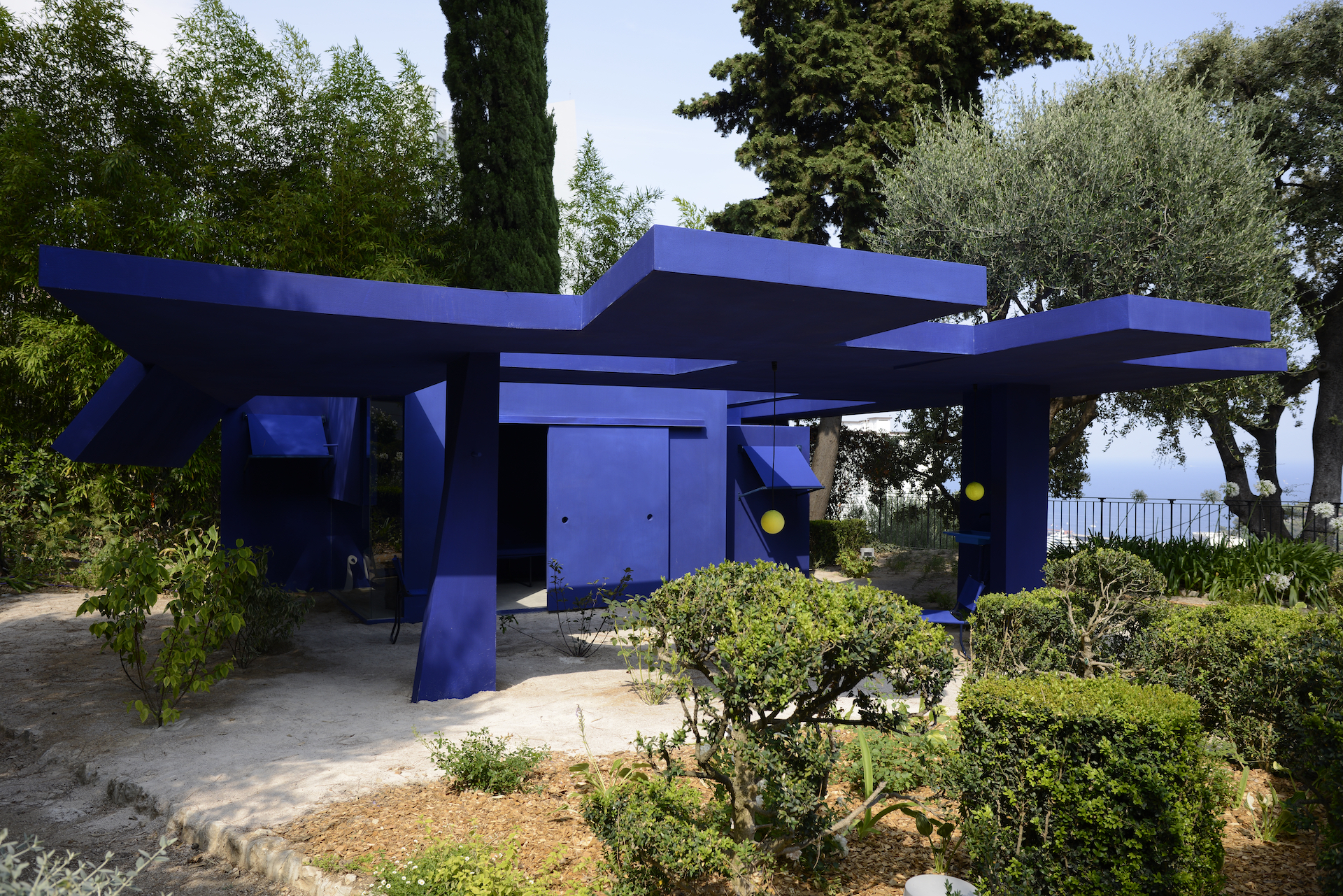
For 15 years or so, Jean-Pascal Flavien has been building weird houses here, there and everywhere in the world, from Rio to Berlin, and from Pougues-les-Eaux to Monaco. If we had to make do with a cursory definition, his architectures might be defined as sculpture-houses or inhabitable/live-in sculptures, and it is true that they have all the functional qualities which hallmark a dwelling, even if the conditions of this dwelling seem somewhat Spartan: a roof, walls, a few sticks of furniture, a shower room. Flavien’s “houses” also have the attributes of a sculpture, if we stick to a fairly classic definition of this latter, a definition which was forever fuelling discussion throughout the 20th century, after the precepts of Gotthold Lessing had continued to have their effects. This latter in fact singled out two major categories of disciplines, depending on whether one was dealing with static objects or moving objects, and the principal subject was indeed that of the time which irrevocably separates them.1 Belonging to sculpture implies an immediacy in our understanding of the object and the various strategies applied all through the past century, gravitating around this possibility of instant understanding. The concomitance of the spatial inertia of the sculptural object and the system for evaluating this latter, which would culminate in the modernism of artists like Brancusi and Naum Gabo, can only achieve its greatest effectiveness if it clearly expresses the meeting between spareness of form and intelligibility of process.2 From Duchamp onwards, the principle of presentation has taken precedence over the inner nature of the work, while the onlooker acquires a preferential situation. This detour through recent art history seems necessary to us in order to broach the work of Jean-Pascal Flavien, because this latter’s praxis is part of a lengthy process which has seen the foundations of sculpture very much shaken, shifting from a system of immobility to a dialectic of the object and the eye, which frees it from its presuppositions of the previous century.
Old arguments, new challenges
Behind its quip-like appearance, Ad Reinhardt’s definition that “A sculpture is what you bump into when you step back to look at a painting” refers to a stubborn vision of sculpture, as something that we see as a massive, voluminous, and inert object. The opposite of Klein, with his display of the “void”, and his attempt to take sculpture towards the immaterial and levity, rather than the tangible and the dense, here takes on its full meaning, by helping us to imagine the possibility of turning our back on filling up the museum or commercial space with objects confined in that space. By deconstructing the relation which connects the work to its presentation system, Klein created a crisis in the way the fine arts system and its commercial counterpart work: what is on view is no longer pearls in their jewellery box, it is the box itself, seen as a sophisticated tool for promoting the work as merchandise.3 This unexpected reference to the judoka artist (although the colour of the folding house is, to say the least, disturbing) nevertheless makes it possible to create the link with Flavien’s activities. At once containing the work and the work’s content, by organizing and delimiting their own display and presentation space, the sculpture-houses make the usual ways of understanding sculptural objects obsolete, as well as their possible inclusion in the commercial system. We can, in a way, reckon that the traditional attributes of sculpture, the absence of usefulness and the delimitation of a more or less stabilized volume, are not at work in Flavien’s case. In an intuitive way, the sculpture house concept seems paradoxical insomuch as it intermingles a functional dimension, habitation, and a non-utilitarian dimension, that of aesthetics.
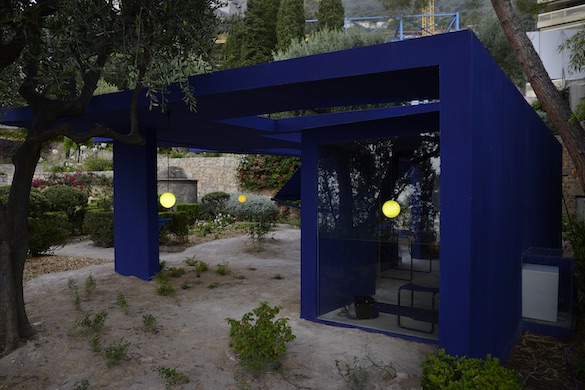
Jean-Pascal Flavien, folding house (to be continued), 2016.
NMNM, 56 Bd du jardin exotique, Monaco, 2,7 × 8,9 × 9,4 m. Courtesy Galerie Esther Schipper, Berlin.
Living in sculpture
So, to broach what we may suitably call, by default, his inhabitable or live-in sculptures, it is necessary to imagine a conceptual pedestal other than the one which governs the usual relations between architecture and sculpture, for example, or between space and sculpture, or between an “aestheticized inhabitability” and more commonplace concerns which stem from interior architecture, decoration, furniture, and design, in so far as it is possible to relegate these concerns to trivial considerations at a time when the IKEAization of the planet is dictating its household standards in a much more intrusive and universal way than any modernist architect would ever have imagined. Even if the artist has no wish to re-enact that debate (of modernism), it must nevertheless be acknowledged that his houses have something to do with the Spartan character of Le Corbusier’s Unités d’habitation: a limited colour range, a similar spareness of furnishing, structures to be considered more like matrices giving rise to derivative forms than receptacles designed to accommodate exogenous elements, which is what furniture, knick-knacks, and artworks can be… Except that, in their very principle, Flavien’s various dwelling projects differ radically from those of “Le Corbu”, because, for example, they are not definitively aimed at the longevity or collectivity lying at the root of Corbusier’s utopia. Precisely where the Swiss architect claimed that he wanted to control, time-wise, the everyday exercise of collective cohabitation and its rational organization, Flavien’s houses are, above all, isolated and unconnected machines, designed for a small habitat: where the star of modernist architects had in his sights the impossible dragooning of a heterogeneous population, Flavien’s houses comply with a logic of rarity and individuality; they are in no way meant to act as a model for infinitely repeatable modules. Le Corbusier’s dwelling unit is not that of his duplexes but rather that of the housing project in its very organicity. Conversely, Flavien’s dwelling unit is an isolated, autonomous construction: this latter designs and produces his houses in the interstices of what already exists, small ephemeral cavities of the metropolis.4 Each one of his projects has its own logic, and a single aim: living in one of his houses is like playing a musical instrument. So the breathing house is a house with variable geometry—whence its name—which expands and contracts depending on the willingness of its inhabitants: walls shift, corridors change, daytime furniture takes the place of night-time furniture at dawn, etc. The whole house can be altered in its inner and outer configuration, so it powerfully calls to mind a wind instrument, such as a trombone. The viewer, produced in Brazil in 2007, already had all the features which would define the houses to come: a sole purpose, which was to steer the eye, an optimized inhabitability for a single person, an unlikely location and, above all, a powerful link to language via, among other things, a series of publications resulting from the brief sojourns of residents. But it is no longer a matter of dealing with the worrying issue of the collective organization of the masses: in terms of comfort, Flavien’s houses are not very finished—we can even use the term degree zero. When someone like Le Corbusier, or any other architect, deals with the issue of habitat, it is in order to imbue it spontaneously with a deafening economic and functional dimension; when Flavien earmarks some kind of purpose for his projects, they are unexpected, disconcerting commands, like the order to read, draw, talk, or dance6 : so it is with the two persons house which, as its name suggests, is designed above all for two people to live in. Its distinct spaces, carefully delimited and antagonistically coloured with red and blue, have the effect of a gigantic game of lego, where the various parts are dovetailed and overlapped, while the two sets of furniture, cubic and/or parallelepiped, can be moved by each of the two players: needless to say, everything here seems underpinned and prompted by the idea of a dialogue and a peaceful confrontation between the two occupants, with the objects filling the space being more like shifters for a potential dialogue than furniture which furnishes. But when a thoroughly individualistic dimension seems to predominate in Flavien’s projects—sorts of caves inviting us to retreat and isolation—, this withdrawal seems to liberate a creative energy and a state of living together, much more than any utopian projection resulting from modernist thinking.
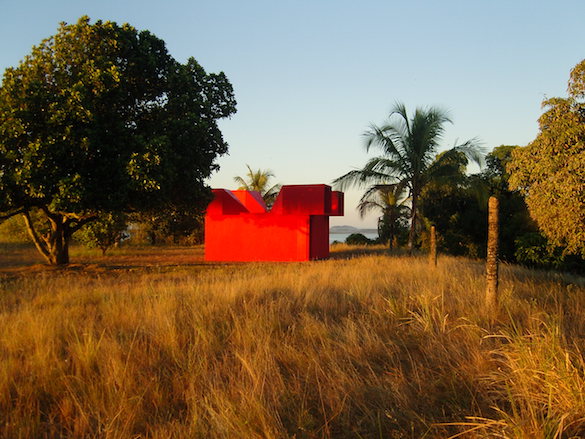
Jean-Pascal Flavien, viewer, 2007. Maricá, Rio de Janeiro, 4 × 7,7 × 4,9 m. Courtesy Galerie Catherine Bastide, Bruxelles.
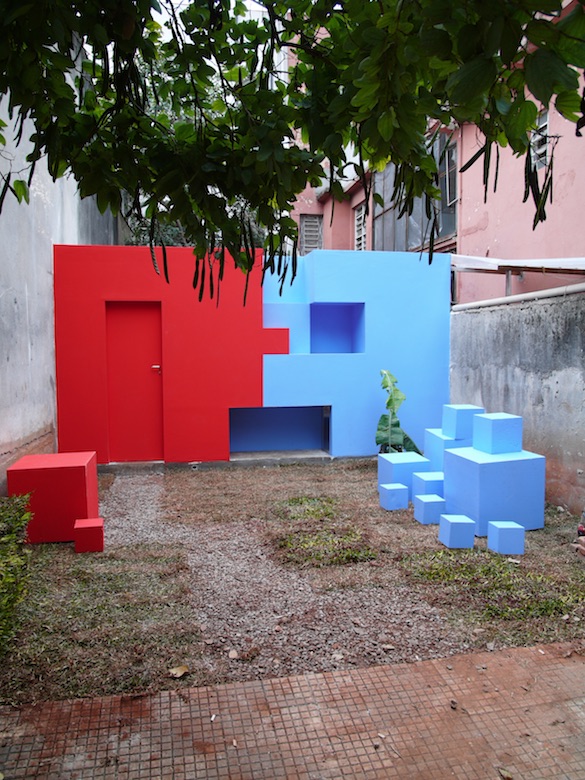
Jean-Pascal Flavien, two persons house, 2010. 2,4 × 4,65 × 4,55m. Courtesy Galerie Catherine Bastide, Bruxelles ; Galerie Esther Schipper Berlin.
Shifting
The metaphor of the musical instrument tallies perfectly with Flavien’s houses, because each one of them seems devised for a solitary person, or two people at most. But the musical metaphor can barely work beyond the issue of use; Flavien’s instrument-houses are not provided with an ad hoc score, which would be tantamount to a user’s manual. It us up to the guests, recruited by the artist in accordance with principles of affinity, to set their ephemeral stays to music. So with his sculpture houses Flavien pulls us towards the question of language: their function is to give rise to words, words which prolong their action by infiltrating them. Even more than language, it is the relation to words that is invoked and wanted because, unlike language, words are alive and incarnate, even if supported by the relation to the vocabulary and grammatical structure. And how can words be summoned other than in a poetic, evanescent dimension, when the aim is not to materially preserve possible linguistic productions? It is tempting to regard Flavien’s arrangements as amplifiers of the sensible, kinds of studios meant to give rise to liberated and floating words, outside of any archival process. The concept of shifters—those words which, in language, simplify liaisons between the various signifier groups, and make the creation of meaning possible—can also act as a reading key for Flavien’s houses, even if, in linguistics, the notion of shifter has a thoroughly defined place; their displacement in the realm of inhabiting seems applicable here. The fact remains that the sculptural dimension of Flavien’s project has trouble holding up in a restricted definition of sculpture, the one bequeathed by debates about modernism and postmodernism. On the boundary of architectural issues, whose collective essence is proudly ignored by this builder’s projects, these latter have a complex relation with sculpture, whose definition they strangely cause to evolve towards much more lively shores, grappling with onlookers/users: it is the very definition of these latter which is thereby radically altered, as it is absolutely unthinkable to regard them as a mere public or audience. Flavien’s “sculptures” call for a more intense approach than the one we have been accustomed to since the 20th century: in order to “really” understand them, it must be possible to live in them, learn to play with them, and speak their language, so it is a matter of going much further than applying a simple intellectual understanding, or a simple formal and psychological assessment between an object endowed with intelligence and intentions, and an onlooker contemplating it.
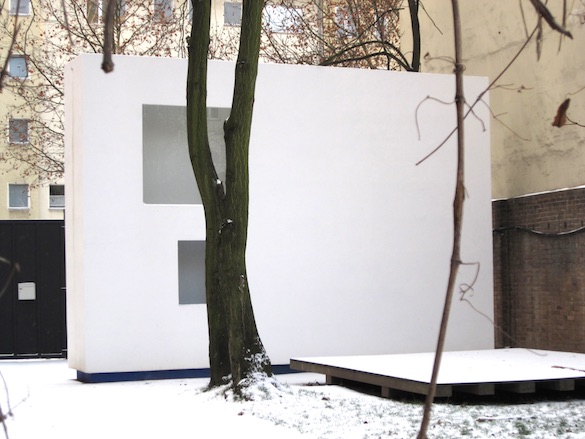
Jean-Pascal Flavien, no drama house, 2009.
Kurfürstenstraße 20, Berlin, 5,5 × 7,75 × 1,2 m. Courtesy Galerie Catherine Bastide.
Unmasking
The folding houses, like the one that has just been erected in the garden of the Villa Paloma, in Monaco, represent a new step forward, an extra degree of complexity in the Berlin artist’s œuvre. Although his earlier projects were already greatly devoted to language, like the no drama house and the two persons house, where the lines of the furniture formed nothing less than sentences following something almost akin to a syntactic sequence, with the folding houses, Flavien continues this use of the realm of words: here we are no longer faced with diverse elements of language, different words of a metaphorical vocabulary arranged so as to form a “sentence”, a bit like the way Guy de Cointet arranged stage props in his famous performances Tell Me (1981) and Ethiopia (1976). With the folding houses, the artist is saying that he wants to go beyond this organization of space which we find in the above-mentioned projects: henceforth, it is words (incited, provoked during events or simply contingent upon the simple fact of living in and sharing a dwelling place) which will form the “extra” space of houses, and prolong the tangible space that is presented, for its part, in its sculptural form. The two spaces are prolonged, and dovetailed, with the immaterial element being overlaid on the physical aspect, and informing it. But the folding houses lie at the root of veritable masks7 which, by unfolding and developing, become walls, openings, pillars, etc. We saw earlier how Flavien’s houses might be compared with musical instruments: here, the mask-house becomes the spreader of a powerfully claimed and mythicized word, amplified by the power of the whole arrangement, and loaded with all the symbolism of the mask through history and art history.
In fact if we step back a bit, living in this house is tantamount to living in a huge loudspeaker, the metaphorical amplifier of a lived-in word, which also lives in it. Needless to say, the relation with African statuary and the identity and psychological backdrops complicate our understanding of the work by loading it with additional layers of reading, but, already, the “simple” consideration of the folding house as a house which “speaks” and which is spoken by its occupants through the simplicity and force of its system is enough to make us more than enthusiastic, and revive old debates about sculpture.
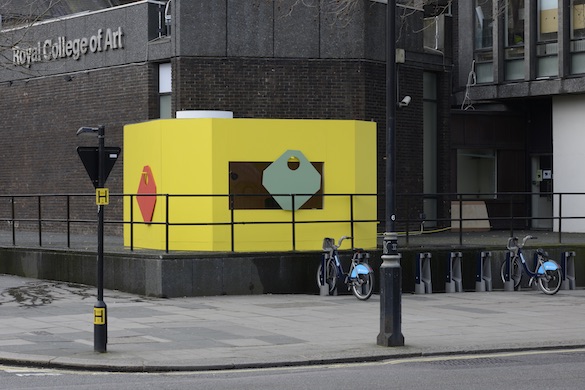
Jean-Pascal Flavien, statement house (temporary title), 2015.
RCA, Kensington Road, London, 2,6 × 4,5 × 4,5 m. Courtesy Galerie Catherine Bastide Bruxelles ; Galerie Esther Schipper Berlin.
1 “Therefore, in answer to the question: ‘What is sculpture?’, Lessing asserts that sculpture is an art concerned with the deployment of bodies in space. And, he continues, this defining spatial character must be separated off from the essence of those art forms, like poetry, whose medium is time”. Rosalind Krauss, Passages in Modern Sculpture, 1977, The Viking Press, p. 3.
2 “For the meaning of most art objects is lodged within a mesh of ideas and feelings held by the creator of the work, passed through the act of authorship into the work, and thereby transmitted to a viewer or reader of it. The traditional work is thus like a transparent pane—a window through which the psychological spaces of viewer and creator open onto each other”. Rosalind Krauss, op. cit., p. 76.
3 “The sacramental nature of the space becomes clear, and so does one of the great projective laws of modernism: as modernism gets older, context becomes content. In a peculiar reversal, the object introduced into the gallery ‘frames’ the gallery and its laws.” Brian O’Doherty, Inside the White Cube, The Ideology of the Gallery Space, University of California Press, 1999.
4 The no drama house was built in the garden of a gallery in Berlin : this sliver of a dwelling, just three feet wide, determinedly accumulates architectural and domestic problems with a deliberate desire to leave them in the lurch. As a problematic house from the outset, it ends up by deactivating the very idea of problems, as often happens in life when you give up trying to solve them…
5 The viewer enjoyed a second version for Art Basel Statement in 2008. The viewer, light architecture, is part of a more complex arrangement of drawings, publications and videos, framing and enriching it.
6 The project being produced by Flavien for the Rennes Biennale, dancers sleeping inside a house, consists in a house dedicated to dance; after the breathing house and the two persons house, this latest work extends the instrument-house concept conceived for a special practice. For the Rennes house, a real choreographic collaboration (with the musée de la danse) will be introduced with a sequence of inspiration-repetition based on a pre-adjusted score for one dancer during the night, followed by a public performance in the day.
7 In her essay about the folding house, Marie de Brugerolle returns to this latter’s genesis: ordinary aluminium sheets with holes made in them which, once enlarged, would become the house itself. These sheets, of the same blue colour as the house, once set vertically and affixed to the wall, become masks calling to mind the famous African masks which, from Picasso to Paul McCarthy (whom Flavien came across during his visits to Los Angeles), continually inspired the whole of 20th century art. There can be no doubt that the re-interpretation of them made by Flavien is part of a principle of re-assessment of these latter. It is in fact essential to think of the Monaco project as the development of a model with the outlines of an African mask, but one which carries within it its many semantic layers and formal updates. (cf. Marie de Brugerolle, in catalogue Construire une collection, Nouveau Musée de Monaco, 2015, p.129-131.)
- From the issue: 79
- Share: ,
- By the same author: Jack Warne, Mondes nouveaux, Kristina Solomoukha, Alun Williams, Ben Thorp Brown,
Related articles
Shio Kusaka
by Sarah Matia Pasqualetti
Julian Charrière: Cultural Spaces
by Gabriela Anco
Céleste Richard Zimmermann
by Philippe Szechter


